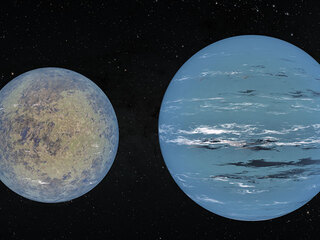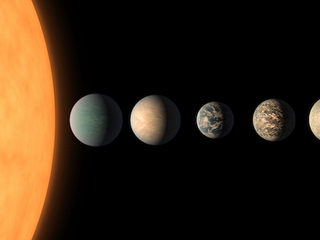News | March 7, 2017
Planet Hunters: Finding beauty in the universe

Beth Biller Credit: Emma Graham
Beth A. Biller is part of an international team of astronomers trying to tease out images of planets around young stars by removing the distortions caused by Earth's atmosphere.
Extrasolar planets are extremely faint targets to begin with, and an atmospheric effect known as "speckling" has thwarted most previous attempts to observe them directly. Using instruments installed at the Very Large Telescope in Chile, Biller's team has constructed some of the highest contrast images every obtained of substellar objects.
Her work is also helping determine requirements for NASA's Terrestrial Planet Finder, a future mission that will directly observe and characterize habitable planets around nearby stars. Currently a doctoral candidate at the University of Arizona, she presented her research in an oral session at this year's winter meeting of the American Astronomical Society. She is a native of the Washington, D.C., area.
PlanetQuest: Where are you in your career right now?
Beth Biller: Currently I'm at that fun stage of the Ph.D. program where, once I write a book, I'm done. For my thesis, I just finished a major paper on our survey of very nearby, young stars looking for extrasolar planets.
Biller and her colleagues obtained this image of a very cool brown dwarf orbiting a star near our sun using a camera on the Very Large Telescope in Chile. (Credit: Beth Biller and Laird Close, UA Steward Observatory, 2006)
PQ: What are your short- and long-term career goals?
Biller: I'd like a job, short term. I really love research astronomy and want to keep on pursuing it. I'd like to become one of the first comparative exoplanetologists -- someone who classifies different types of planets beyond our solar system. But there are a lot of different options in astronomy.
PQ: What do you love about research?
Biller: The daily grind can be frustrating, but the exciting part is when you discover something new. For example, I discovered a brown dwarf last year. I was like: "I'm looking at a world, and I'm the first person ever to see this place!"
PQ: What is the significance of your research?
Biller: We just completed a 50-star survey. With that many objects, we can really say something cool about the distribution of extrasolar planets. We're looking at giant planets, but not as old as Jupiter - they're bigger, brighter, and puffier.
From an astrobiology sense, it's important to understand the architecture of these early systems, because that can determine where earthlike planets can and cannot form. For instance, we're lucky that Jupiter is where it is in our solar system. A lot of known planetary systems have Jupiter-mass planets at Mercury-like distances. But such a planet can't form that close to a star - it has to form at a Jupiter-like distance, and then migrate inward. However, that inward migration would be disastrous for any proto-Earths that might be forming in that solar system!
PQ: Can you remember what originally sparked your interest in astronomy or science?
Biller: I was always interested in astronomy when I was really little. I kind of drifted away until the end of high school. And then, when I was in high school, the first exoplanets were discovered, and that was a big deal. I was like, I don't know if I can make it in this field, but I want to give it a shot. So I went to college. You have to get into physics pretty early on. It was scary, but it was really fulfilling.
The hardest part was fear of math.
PQ: How did you deal with that?
Biller: I just tried not to freak out too much. When I sat down and really worked through it, I was able to catch up. Now, math is not scary. I'm just used to it.
PQ: What do you like to do in your spare time?
In her spare time, Biller pursues an unusual hobby: belly-dancing. (Credit: Douglas Hester)
Biller: I'm a bellydancer. It's not dance of the seven veils, nothing like that. I do a style called American tribal style. You have a leader, and everyone follows the leaders. It's a cool, improvisatory dance form.
PQ: Do you see any linkages between your two interests -- science and dancing?
Biller: Yes. They're both about beauty in different forms: the beauty of the universe and beauty of movement of the human body.
PQ: Any particular advice to other young people who might be considering a career in science?
Biller: If you think you're an unlikely candidate, but still want to do it, then do it. Don't be intimidated. There are all types of people who are scientists, and it's getting more and more diverse.
PQ: Is there any particular teacher who has inspired or motivated you?
Biller: My first college physics teacher. I was taking mechanics and it was very scary -- again because I was afraid of it. He took me aside, and said, "Hey, don't worry about this, I think you'll do fine in this course as long as you buckle down and work." That was very important. If I hadn't gotten that reassurance, I don't think I would have stayed in the field.
PQ: What has been the most exciting moment for you?
Biller: It was really exciting going to Chile for the commissioning run, when we installed the new instrument on the telescope. It was in the middle of nowhere and it looked like Mars. Very, very empty. Just these four enormous telescopes.
PQ: What kind of music do you like?
Biller: Electronic, gothic, bellydance music. Strange indie stuff.
PQ: Name a favorite movie you've seen recently.
Biller: "Eternal Sunshine of the Spotless Mind." That's totally random, though.
PQ: What's the coolest thing about what you do?
Biller: Just finding new stuff. The idea if you discover a planet, it's a new world. It's a place that maybe in the far, far future people could go to. That's pretty inspiring.








